Vasospastic disorder - Study guides, Class notes & Summaries
Looking for the best study guides, study notes and summaries about Vasospastic disorder? On this page you'll find 131 study documents about Vasospastic disorder.
All 131 results
Sort by
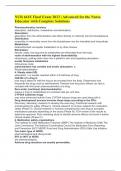 Popular
Popular
-
NUR 641E Final Exam 2023 | Advanced for the Nurse Educator with Complete Solutions
- Exam (elaborations) • 13 pages • 2023
-
- $12.49
- 1x sold
- + learn more
NUR 641E Final Exam 2023 | Advanced for the Nurse Educator with Complete Solutions Pharmacokinetics involves absorption, distribution, metabolism and elimination). Absorption: absorption from the administration site either directly or indirectly into the blood/plasma. Distribution: reversibly or irreversibly move from the bloodstream into the interstitial and intracellular Metabolism: biotransformed via hepatic metabolism or by other tissues. Elimination: tissues. lastly, the drug an...

-
NUR 641E Final Exam 2023 | Advanced for the Nurse Educator with Complete Solutions
- Exam (elaborations) • 17 pages • 2023
-
- $8.49
- 2x sold
- + learn more
NUR 641E Final Exam 2023 | Advanced for the Nurse Educator with Complete Solutions. Metabolism: - ANSWER-biotransformed via hepatic metabolism or by other tissues. Elimination: - ANSWER-tissues. lastly, the drug and its metabolites are eliminated from the body. route of administration with the highest bioavailability - ANSWER-intravenous; putting entire dose into a patient's vein and bypassing absorption. avoids first-pass metabolism - ANSWER-Intravenous route administration has variable and er...
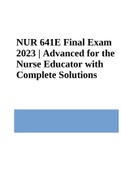
-
NUR 641E Final Exam 2023 | Advanced for the Nurse Educator with Complete Solutions
- Exam (elaborations) • 17 pages • 2023
- Available in package deal
-
- $17.49
- 3x sold
- + learn more
NUR 641E Final Exam 2023 | Advanced for the Nurse Educator with Complete Solutions. Metabolism: - ANSWER-biotransformed via hepatic metabolism or by other tissues. Elimination: - ANSWER-tissues. lastly, the drug and its metabolites are eliminated from the body. route of administration with the highest bioavailability - ANSWER-intravenous; putting entire dose into a patient's vein and bypassing absorption. avoids first-pass metabolism - ANSWER-Intravenous route administration has variable ...
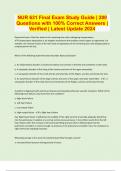
-
NUR 631 Final Exam Study Guide | 200 Questions with 100% Correct Answers | Verified | Latest Update 2024
- Exam (elaborations) • 75 pages • 2024
- Available in package deal
-
- $15.49
- + learn more
Removal of part of the liver leads to the remaining liver cells undergoing compensatory - Compensatory hyperplasia is an adaptive mechanism that enables certain organs to regenerate. For example, the removal of part of the liver leads to hyperplasia of the remaining liver cells (hepatocytes) to compensate for the loss. Which of the following statements best describes Raynaud disease? a. An inflammatory disorder of small and medium-size arteries in the feet and sometimes in the hands b. A n...
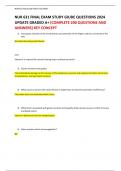
-
NUR 631 FINAL EXAM STUDY GIUDE QUESTIONS 2024 UPDATE GRADED A+ (COMPLETE 200 QUESTIONS AND ANSWERS) KEY CONCEPT
- Exam (elaborations) • 36 pages • 2023
-
- $13.49
- + learn more
NUR 631 FINAL EXAM STUDY GIUDE QUESTIONS 2024 UPDATE GRADED A+ (COMPLETE 200 QUESTIONS AND ANSWERS) KEY CONCEPT 1) Vasospastic disorder of the small arteries and arterioles of the fingers and less commonly of the toes Best describes Raynauds Disease Liver Vitamin K is required for normal clotting factor synthesis by what? 2) Gluten sensitive eneropathy Characterized by damage to the mucosa of the duodenum, jejunum
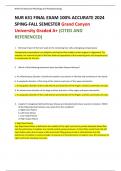
-
NUR 631 FINAL EXAM 100% ACCURATE 2024 SPING-FALL SEMESTER Grand Canyon University Graded A+ (CITED AND REFERENCED) ALL 150 QUESTIONS
- Exam (elaborations) • 58 pages • 2023
-
- $13.49
- + learn more
NUR 631 FINAL EXAM 100% ACCURATE 2024 SPING-FALL SEMESTER Grand Canyon University Graded A+ (CITED AND REFERENCED) ALL 150 QUESTIONS 1. Removal of part of the liver leads to the remaining liver cells undergoing compensatory Compensatory hyperplasia is an adaptive mechanism that enables certain organs to regenerate. For example, the removal of part of the liver leads to hyperplasia of the remaining liver cells (hepatocytes) to compensate for the loss. 2. Which of the following statements bes...
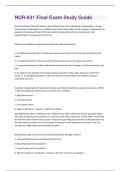
-
NUR-631 Final Exam Study Guide Graded A+
- Exam (elaborations) • 70 pages • 2024
- Available in package deal
-
- $9.49
- + learn more
Removal of part of the liver leads to the remaining liver cells undergoing compensatory - Answer Compensatory hyperplasia is an adaptive mechanism that enables certain organs to regenerate. For example, the removal of part of the liver leads to hyperplasia of the remaining liver cells (hepatocytes) to compensate for the loss. Which of the following statements best describes Raynaud disease? a. An inflammatory disorder of small and medium-size arteries in the feet and sometimes in the hands...
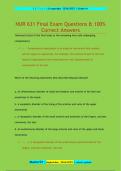
-
NUR 631 Final Exam Questions & 100% Correct Answers
- Exam (elaborations) • 127 pages • 2024
-
- $13.49
- + learn more
Removal of part of the liver leads to the remaining liver cells undergoing compensatory :~~ Compensatory hyperplasia is an adaptive mechanism that enables certain organs to regenerate. For example, the removal of part of the liver leads to hyperplasia of the remaining liver cells (hepatocytes) to compensate for the loss. Which of the following statements best describes Raynaud disease? a. An inflammatory disorder of small and medium-size arteries in the feet and sometimes in the ha...
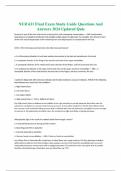
-
NUR 631 Final Exam Study Guide Questions And Answers 2024 Updated Quiz
- Exam (elaborations) • 68 pages • 2024
-
- $14.99
- + learn more
NUR 631 Final Exam Study Guide Questions And Answers 2024 Updated Quiz Removal of part of the liver leads to the remaining liver cells undergoing compensatory ANS Compensatory hyperplasia is an adaptive mechanism that enables certain organs to regenerate. For example, the removal of part of the liver leads to hyperplasia of the remaining liver cells (hepatocytes) to compensate for the loss. Which of the following statements best describes Raynaud disease? a. An inflammatory disorder of s...
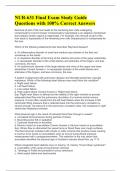
-
NUR-631 Final Exam Study Guide Questions with 100% Correct Answers
- Exam (elaborations) • 51 pages • 2024
- Available in package deal
-
- $13.99
- + learn more
Removal of part of the liver leads to the remaining liver cells undergoing compensatory Correct Answer Compensatory hyperplasia is an adaptive mechanism that enables certain organs to regenerate. For example, the removal of part of the liver leads to hyperplasia of the remaining liver cells (hepatocytes) to compensate for the loss. Which of the following statements best describes Raynaud disease? a. An inflammatory disorder of small and medium-size arteries in the feet and sometimes in the...

Did you know that on average a seller on Stuvia earns $82 per month selling study resources? Hmm, hint, hint. Discover all about earning on Stuvia


